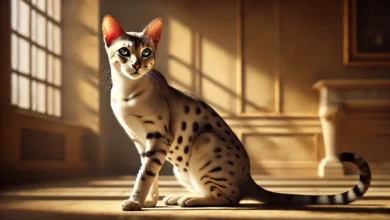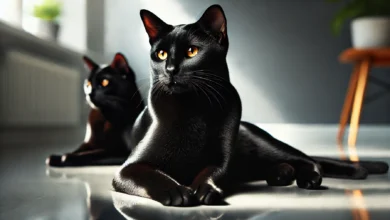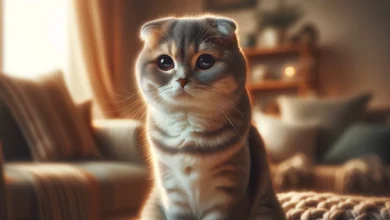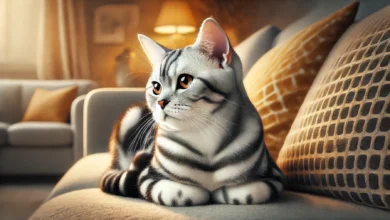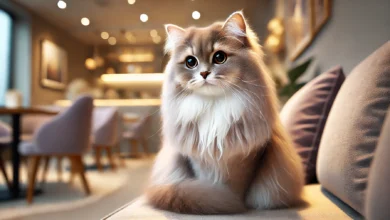Discovering Peterbald Cats: Elegant and Hairless
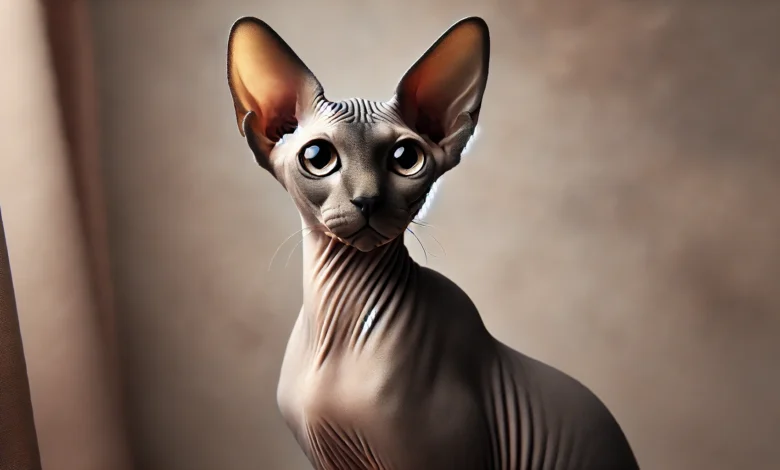
The Peterbald is an outstanding, amazing cat breed that enchants everyone who sees it.
Its sleek and lean body, combined with its hairless appearance in many cases, makes it one of the most strikingly looking yet loving cat breeds.
Hailing from Russia, the feline magic of Peterbalds is hard to resist for genuine cat lovers, especially those fond of rare and unique varieties.
If you’ve ever been intrigued by these stylish cats or are considering adding one to your family, this article will take you through everything there is to know about Peterbalds—from their rich history to their unique care needs.
Table of Contents
What Are Peterbald Cats? A Look Into Their Unique Appearance
Peterbald cats are mainly admired for their hairlessness, but not all Peterbalds are completely bald.
In fact, they come in different coat types, one of the many characteristics that make this breed so interesting.
Some Peterbalds are fully hairless, while others have short, fine coats or even a fuzzy velvet-like coat that gives their skin a soft texture.
This is due to their unique genetics, which allow for variation in coat types even within the same litter.
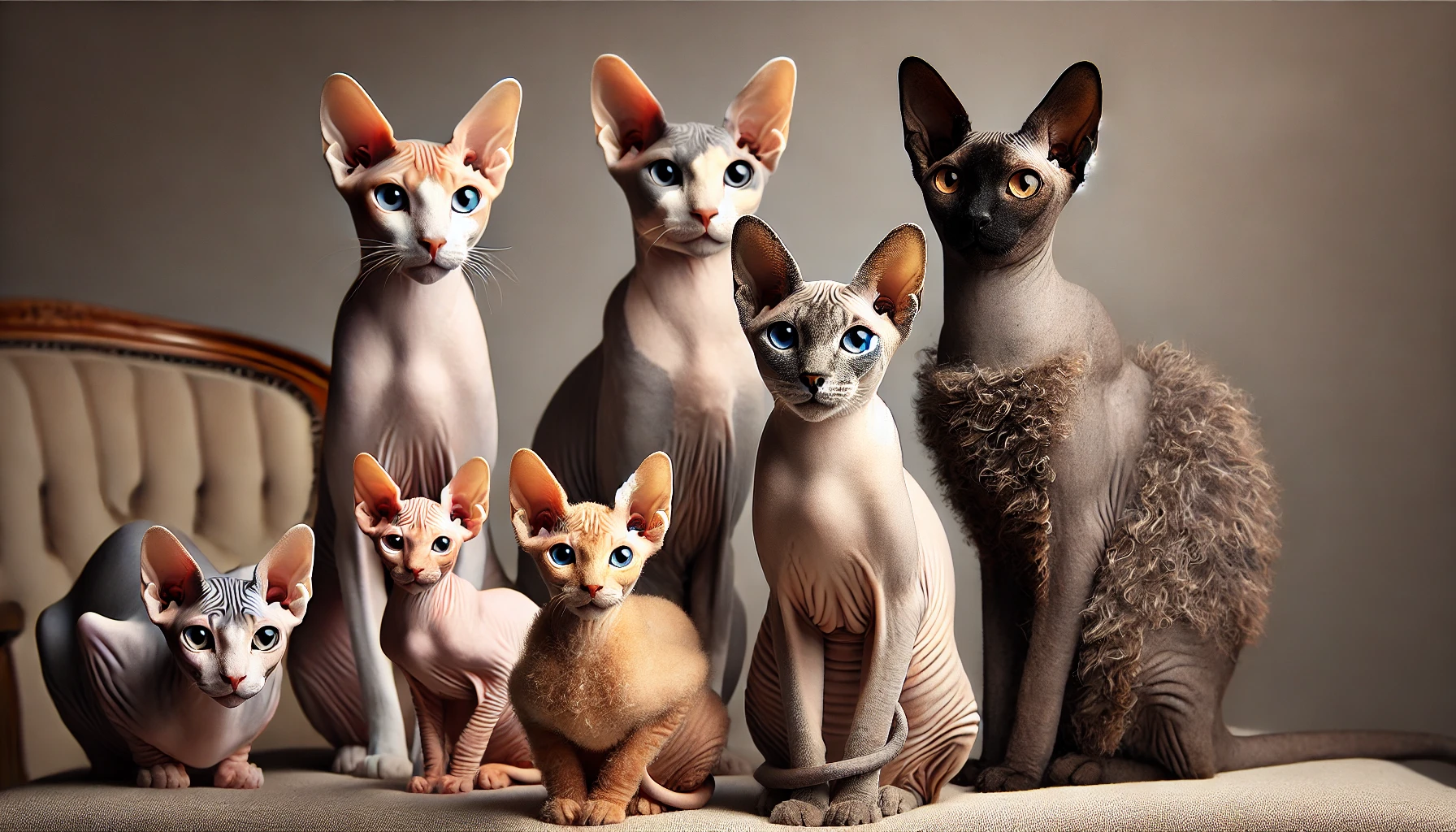
Hairless or Coated: Types of Peterbald Cats
The varieties of Peterbald cats include:
- Hairless: Hairless Peterbalds have smooth, naked skin that feels suede-like to the touch. They are often compared to other hairless breeds, such as the Sphynx.
- Velour: Peterbalds with a thin layer of short, soft fur. Their coat is sparse, giving them a velvety texture, similar to peach fuzz.
- Brush Coat: This type has a wiry, dense coat that feels rough to the touch. While they are not hairless, their fur is quite different from that of most cats.
- Flock: These Peterbalds have an extremely fine, nearly invisible layer of down-like fur.
Despite their hairless gene, Peterbalds can come in any color or pattern, which adds to their beauty and diversity.
Whether completely bald or lightly coated, their slender frame, almond-shaped eyes, and distinctive appearance contribute to their exotic and aristocratic look, setting them apart from other breeds.
The head shape of Peterbald cats is also unique, with large, bat-like ears and a long, narrow nose.
This exotic, almost out-of-this-world beauty has earned Peterbalds a growing fan base worldwide.
What do you find more striking about Peterbald cats, their look or their hairlessness?
Either way, it’s impossible to deny that this breed catches the eye of anyone who encounters them.
Peterbald cats are admired for their hairlessness and diverse coat types, making them stand out among other breeds.

History of Peterbald Cats: A Very Interesting Origin
The origin of Peterbald cats is relatively modern but intriguingly rich.
First developed in Russia during the 1990s, this breed is fairly new to the world of cats.
The breed came into being through the conscious crossbreeding of two different cat breeds, namely the Oriental Shorthair and the hairless Donskoy cat, also originating from Russia.
This combination resulted in a slender, elegant cat with the refined features of the Oriental Shorthair and the unique hairlessness of the Donskoy.
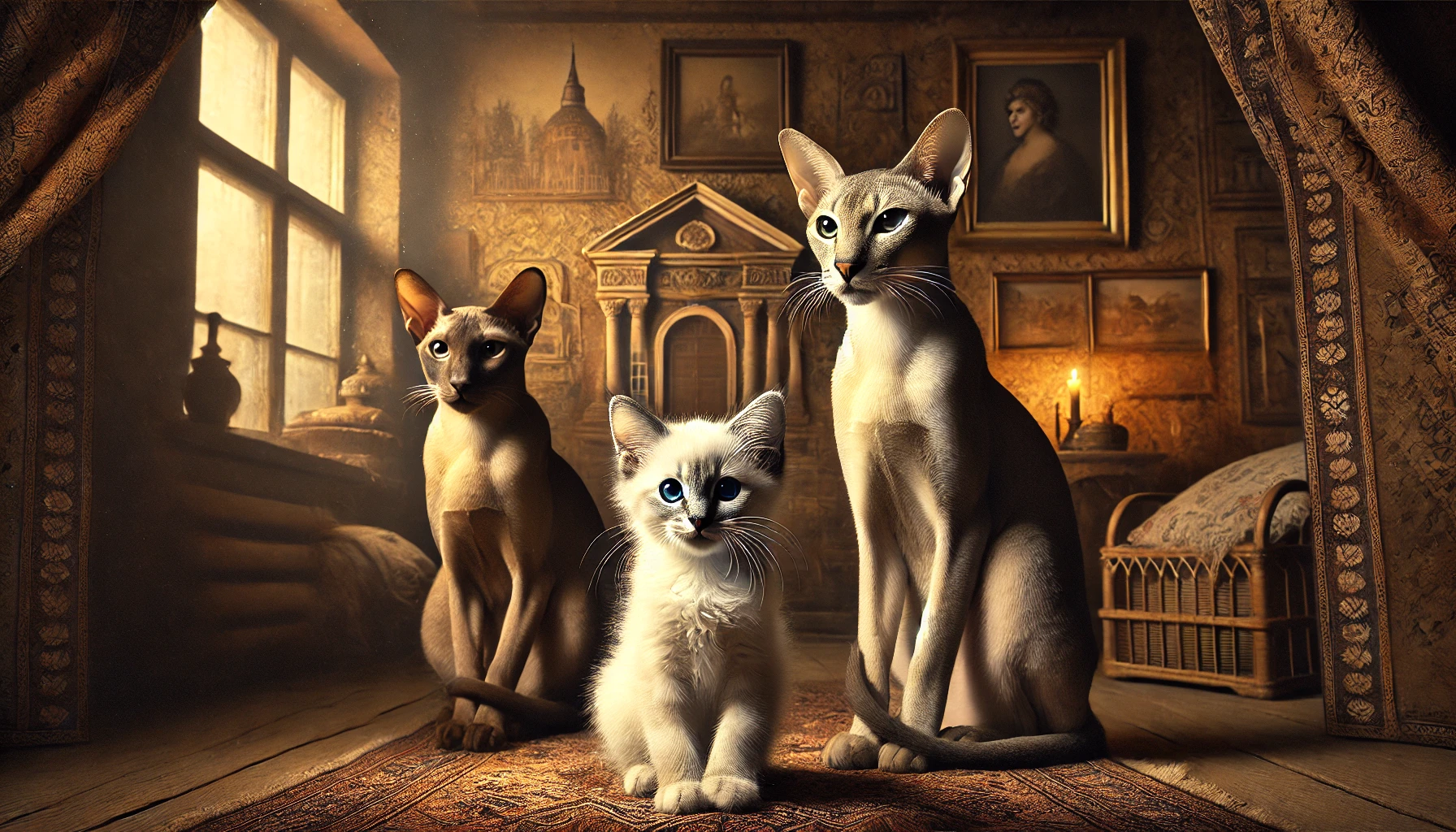
The Birth of the Peterbald: Roots from Russia
The Peterbald breed officially began in 1994 when Russian feline geneticist Olga S.
Mironova paired a male Donskoy cat, Afinogen Myth, with a female Oriental Shorthair, Radma von Jagerhov.
The desired features of both breeds came through in this litter of kittens, from their hairlessness to their elegance and slender, athletic build.
These kittens went on to become the foundation of the Peterbald breed.
Due to its unusual appearance and character, the Peterbald was promptly recognized, and in 1996, the Russian Selectional Feline Federation accepted the breed.
Over time, the breed gained popularity outside of Russia, especially in Europe and the United States, due to its rare and exotic traits.
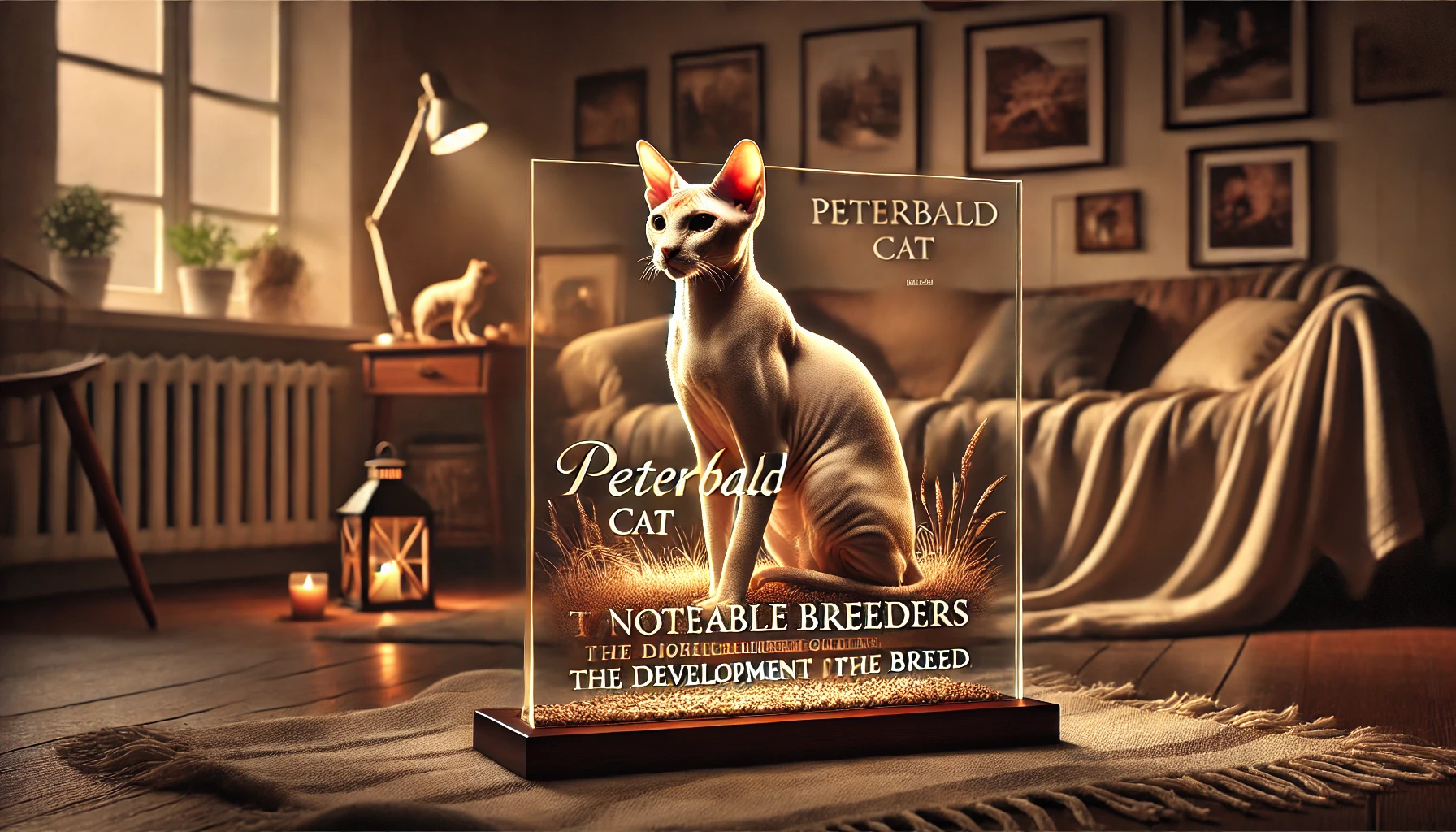
Notable Breeders and Their Contribution to the Peterbald
The Peterbald breed owes much of its development and promotion to the tireless efforts of dedicated breeders.
Russian breeders, followed by breeders from other countries, have helped refine the breed over the years, ensuring that Peterbald cats maintain their slender, graceful bodies and friendly, affectionate personalities.
- Olga Mironova: The founding mother of the Peterbald breed, she initiated the development of this beautiful cat.
- Elena Birjukova: Another fundamental breeder in the early development of the Peterbald breed.
- European Breeders: As the breed gained international recognition, European breeders became instrumental in refining and perfecting the breed’s gene pool, ensuring healthy and balanced litters.
Today, Peterbalds are recognized by several international cat registries, such as The International Cat Association (TICA) and the World Cat Federation (WCF).
Their distinctive looks and extremely friendly nature have won them many followers among feline fanciers worldwide.
Have you ever wondered how a cat breed develops from its creation to becoming internationally recognized?
The Peterbald’s journey is a perfect example of how selective breeding and dedication can create a breed that stands out for both its appearance and personality.
The Peterbald breed originated in Russia in the 1990s through the crossbreeding of the Donskoy and Oriental Shorthair cats.
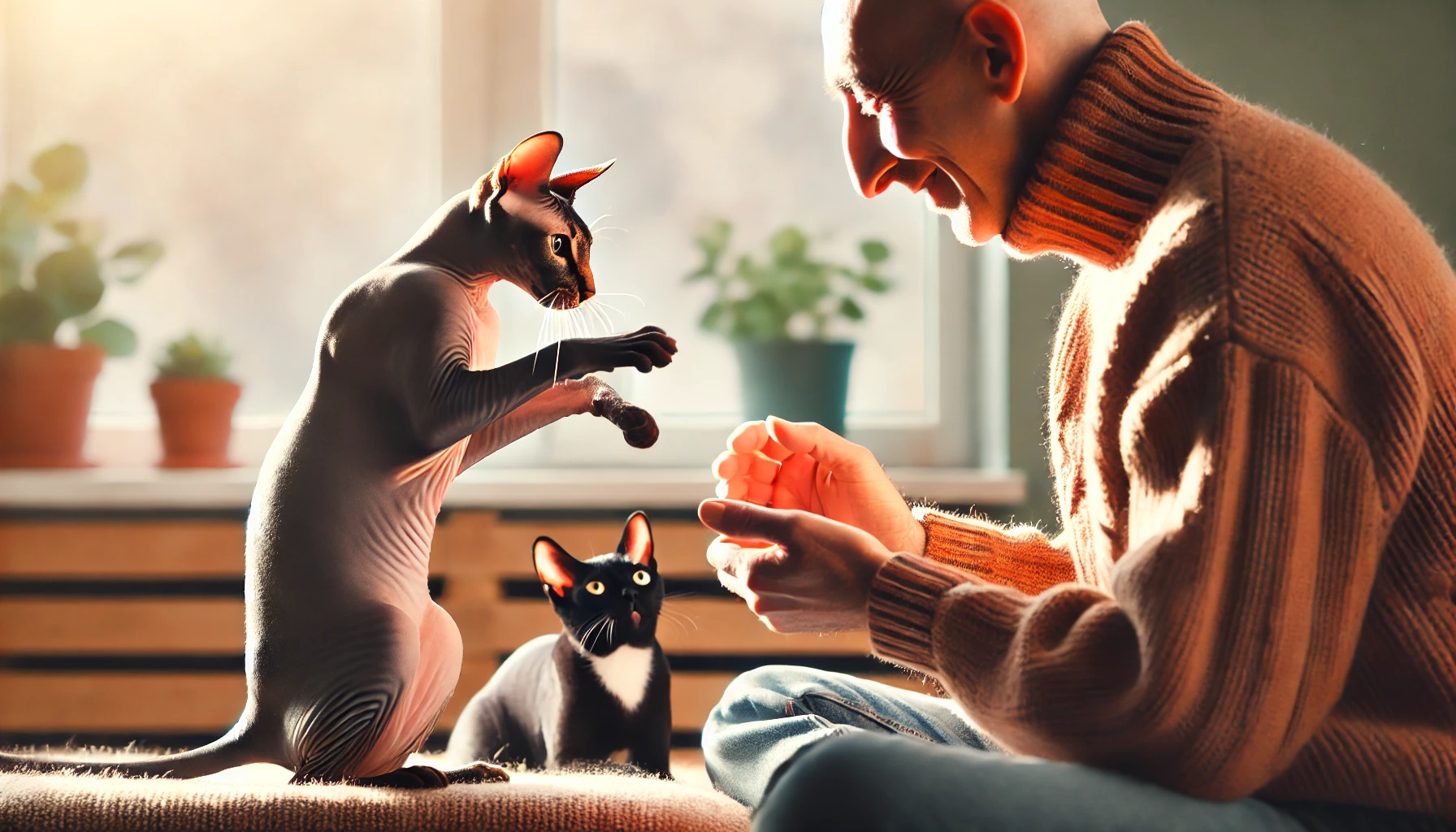
Peterbald Personality and Temperament: What to Expect
Besides their sleek, good looks, Peterbald cats also stand out for their personalities: loving and playful.
Social and keen on the company of their kin, Peterbalds develop deep attachments to their families.
Once you bring one home, you can expect an affectionate, playful, and loyal companion, always ready to engage with you and be a part of the family dynamics.
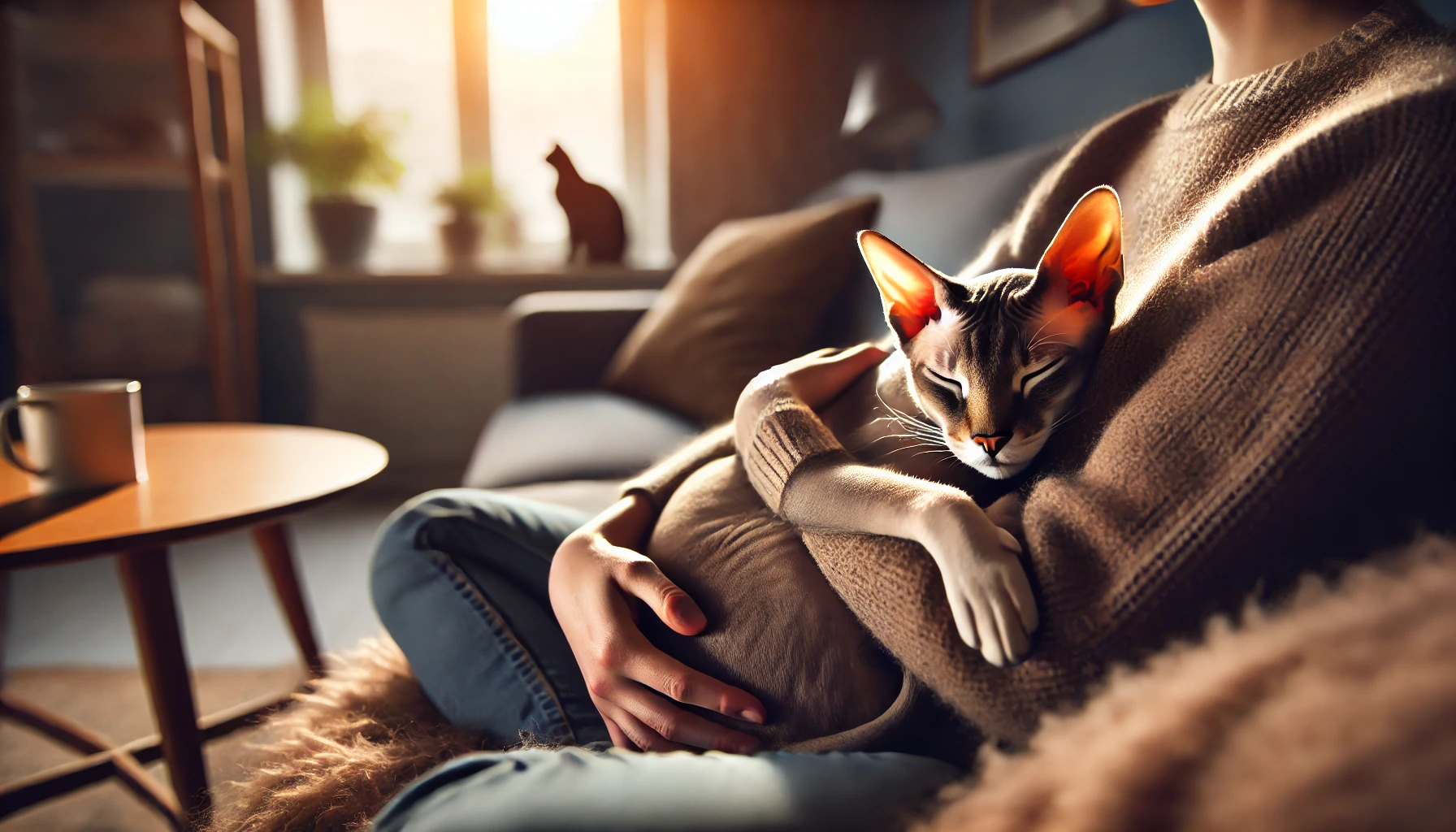
Social and Affectionate Nature of Peterbald Cats
The social nature of Peterbald cats is one of their most prominent traits.
They thrive on attention and adore being around their human family members.
Often described as ‘dog-like,’ Peterbalds follow their owners from room to room and prefer staying in close contact at all times.
These cats love to snuggle in laps, huddle up next to you on the couch, or even sleep beside you in bed.
However, Peterbalds do not do well if left alone for too long.
Owners should keep this in mind when considering adding a Peterbald to their family.
If you have a busy life, another pet or a variety of stimulating activities can help keep your Peterbald happy while you are away.
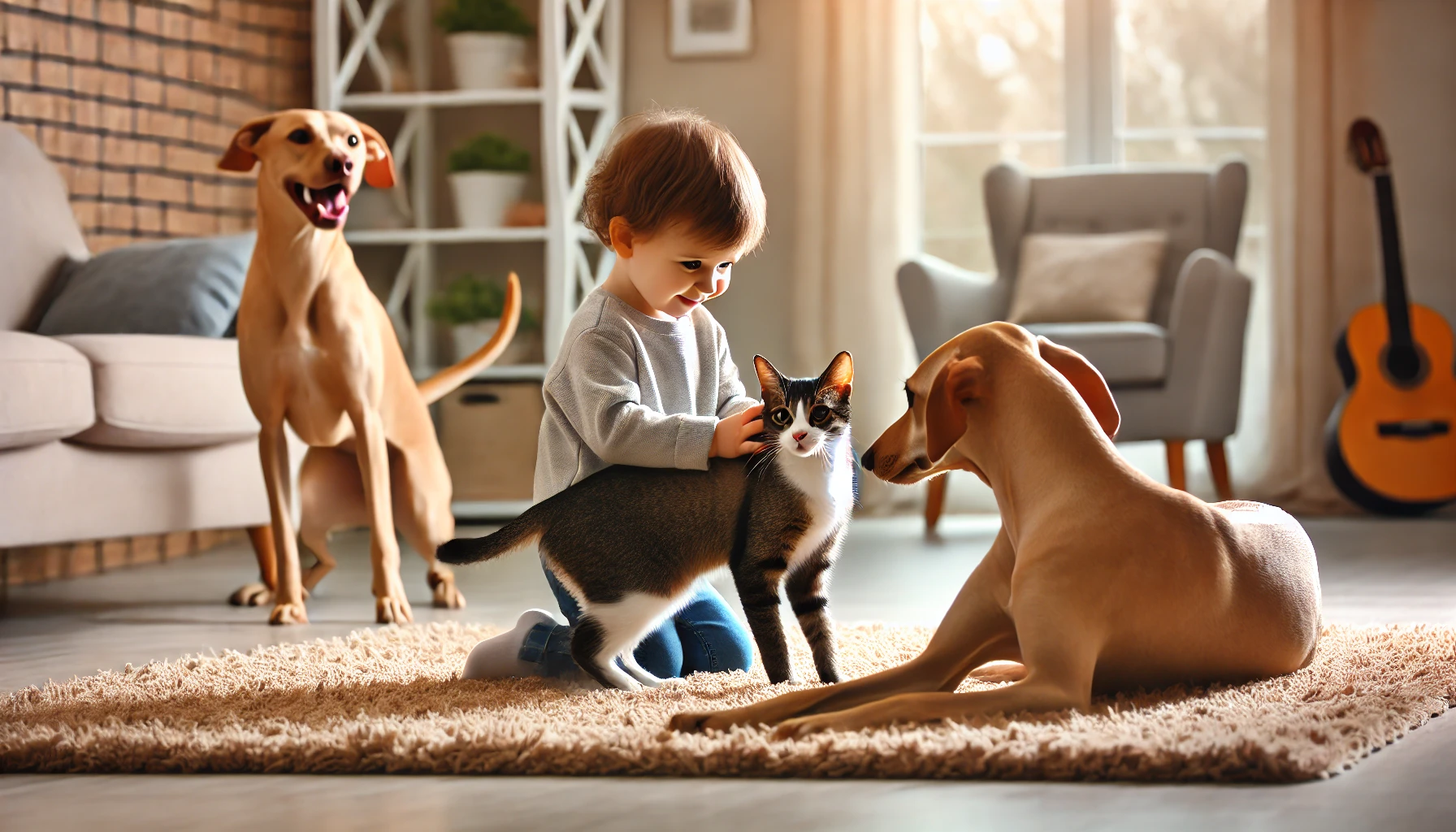
How Peterbalds Interact With Other Pets and Children
Peterbald cats are generally friendly, easy-going, and adaptable, making them well-suited for homes with children or other pets.
They tend to get along well with other animals, such as dogs, and can easily fit into a multi-pet household.
Their playful and curious nature means they enjoy engaging not just with people, but with other animals as well, often initiating playtime or games.
When it comes to children, Peterbalds are gentle and tolerant.
Their affectionate and patient temperament makes them ideal companions for kids, as long as the children are taught to handle the cat with care.
Peterbalds are less likely to scratch or become aggressive in stressful situations, making them great pets for families.
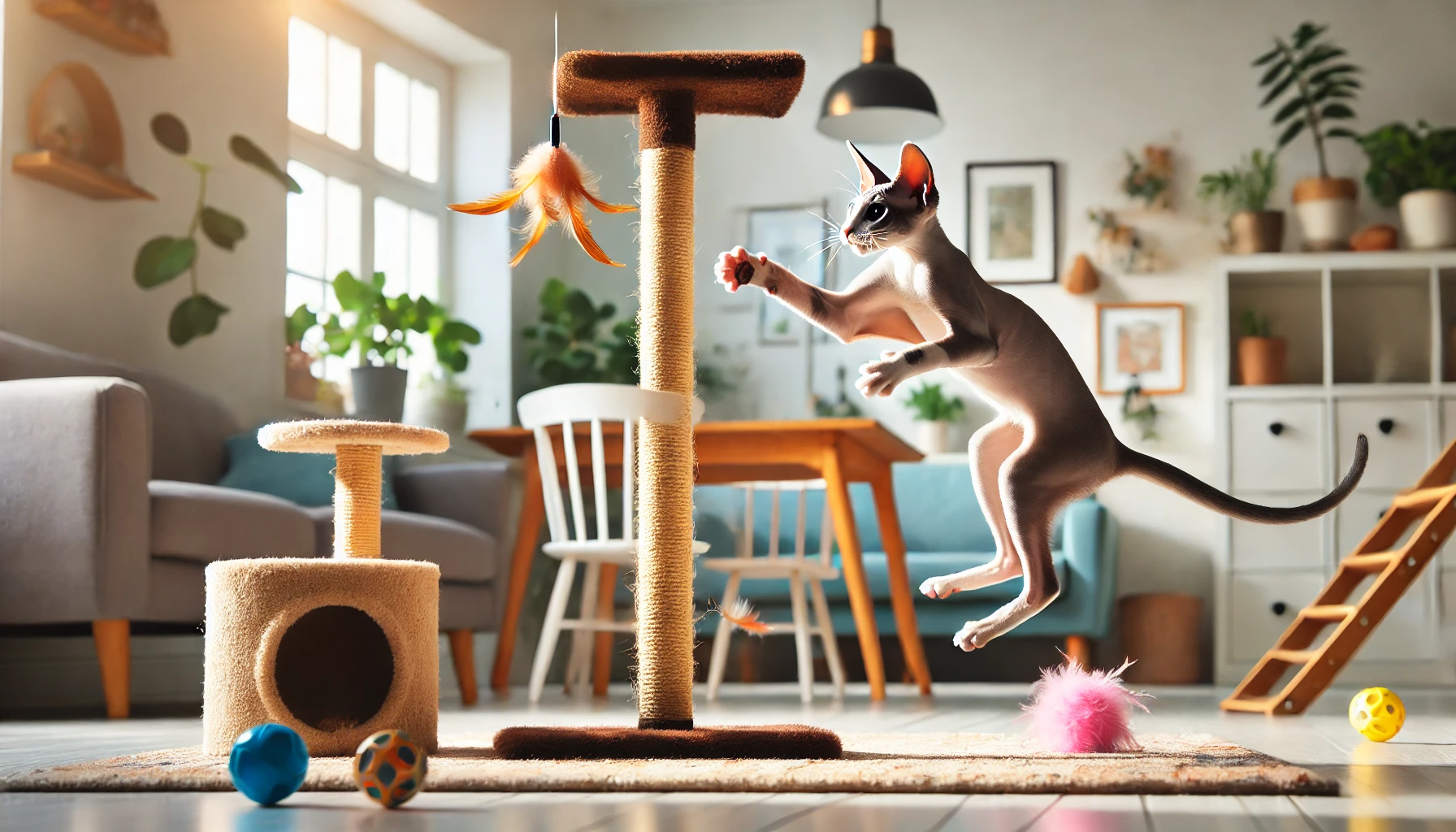
Energy Levels and Playfulness
Peterbald cats are energetic and playful.
They love to climb, explore, and play with toys.
Regular interactive play sessions with their owners are highly recommended to keep them mentally and physically stimulated.
With their slender, athletic build, Peterbalds are agile and active, excelling at jumping and climbing on furniture or cat trees.
The Peterbald is perfect for owners looking for a dynamic and interactive cat.
This playfulness often continues well into adulthood, ensuring that you’ll have an energetic companion for years to come.
Providing plenty of toys, scratching posts, and interactive activities will help them burn off energy and stay happy.
Could you imagine having a cat that behaves more like a dog, clinging to your leg, always ready to play or cuddle?
That’s what you get with a Peterbald: eternal affection, playful energy, and a deep bond with the family.
Peterbald cats are known for their affectionate and playful nature, making them loyal companions.
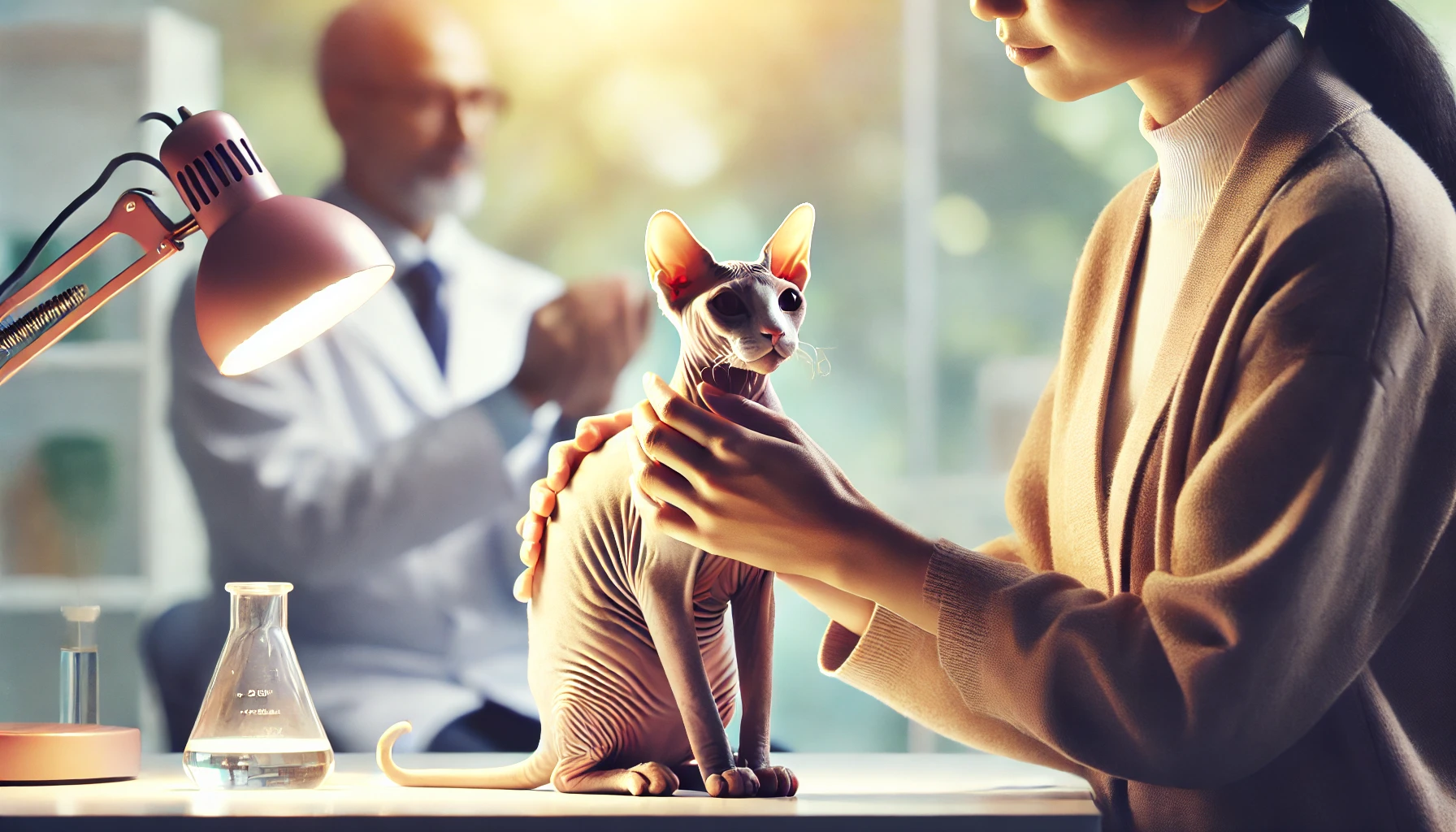
Care and Health Tips for Peterbald Cats
While Peterbald cats are essentially healthy and resilient, their unusual physical traits demand special attention, especially for the hairless variety.
Understanding the health concerns and specific care that a Peterbald requires is important for any responsible owner who wants them to live a long, happy, and healthy life.
From skin care to diet, here are some things you need to know about caring for a Peterbald cat.
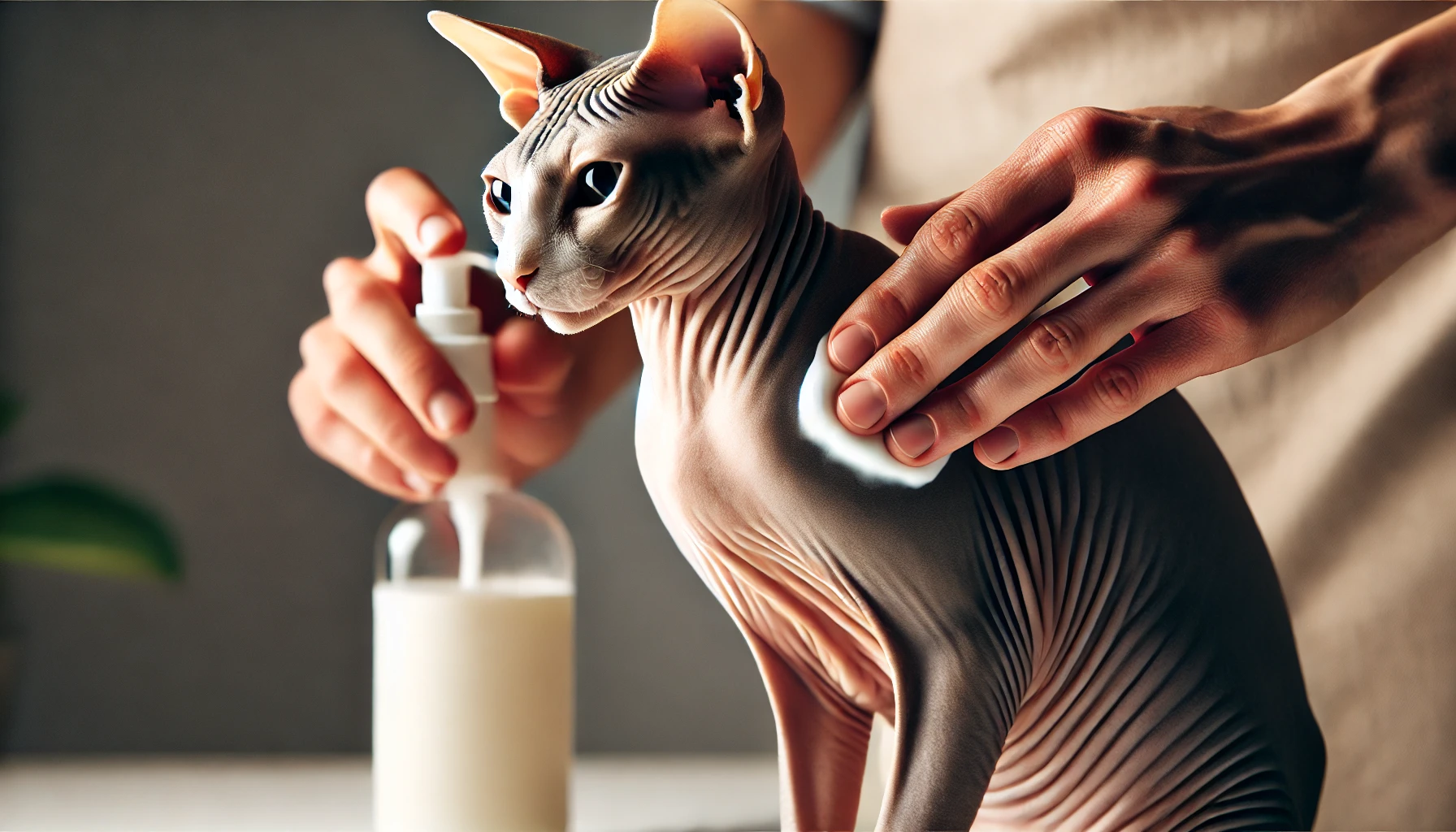
Care of Skin in Hairless Peterbald Cats
Skin care is one of the top priorities when caring for a hairless Peterbald.
Unlike cats with fur, hairless Peterbalds lack a protective coat, leaving their skin exposed to environmental elements such as dirt, sun, and oils.
Without proper maintenance, this can lead to skin problems.
Regular bathing is essential to keep their skin clean and prevent oil buildup.
If not kept clean, their skin can become greasy or develop rashes.
- Bathing: Most Peterbalds require bathing every 1-2 weeks to maintain clean skin and avoid oil buildup. Use a mild, hypoallergenic shampoo formulated for cats, as human shampoos can be too harsh for their sensitive skin.
- Sun Protection: Hairless Peterbalds are prone to sunburns due to their exposed skin. Limit their sun exposure or apply pet-safe sunscreen to prevent sun damage.
- Temperature Sensitivity: Hairless Peterbalds can easily get cold without fur to keep them warm. Ensure they are kept in a warm environment, particularly during colder months, and provide warm blankets or pet sweaters for added comfort.
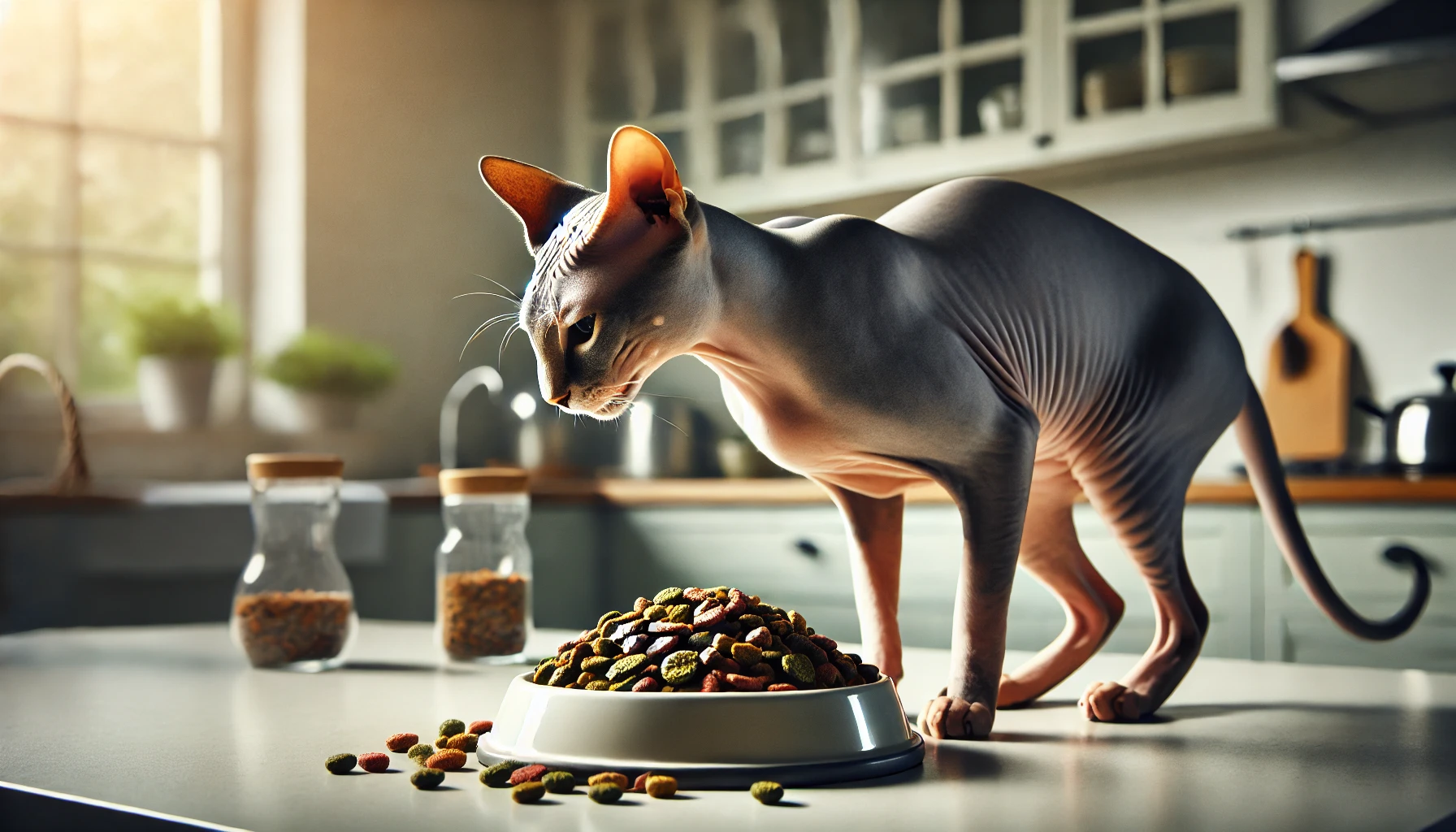
Diet and Weight Management for Overall Health
Peterbald cats are active and athletic, requiring a balanced diet to support their energy levels and overall health.
Because they are more active than average cats, they may need to eat slightly more, but their weight should be carefully monitored to avoid obesity.
- High-Quality Food: Feed your Peterbald a high-protein, nutrient-rich diet that supports their muscles and active lifestyle. Grain-free, premium cat food with real meat as the first ingredient is an excellent choice.
- Portion Control: Despite their energy, portion control is crucial to prevent overfeeding. Consult your veterinarian to determine the right amount of food based on your Peterbald’s age, activity level, and weight.
- Hydration: Encourage your Peterbald to drink plenty of water, especially if they are eating dry food. Proper hydration aids digestion and overall health.
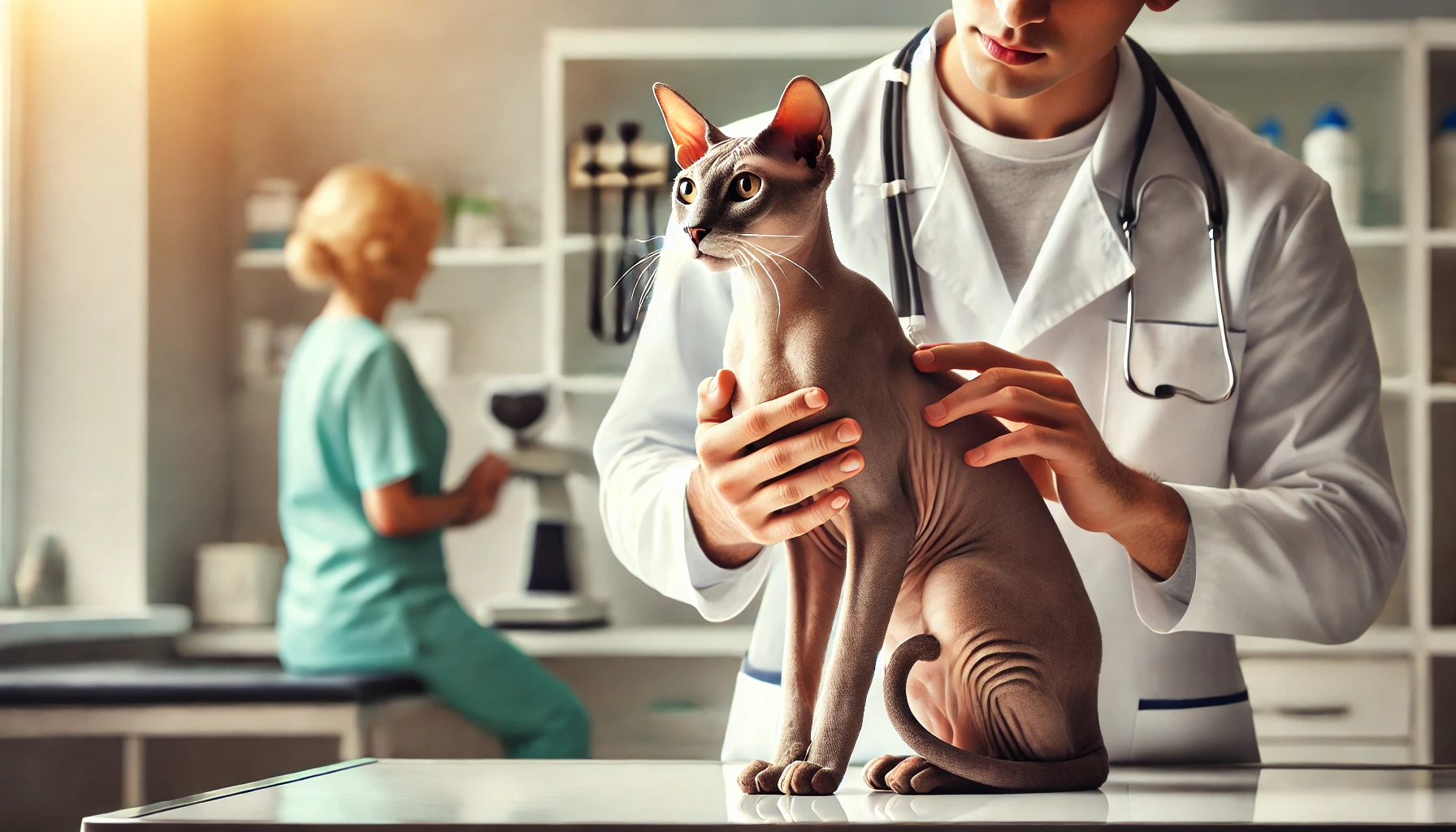
Regular Vet Visits and Common Health Issues
Like all cats, Peterbalds benefit from regular veterinary care.
Though generally a healthy breed, there are some health concerns that owners should keep in mind.
Hairless Peterbalds, in particular, may face skin issues, and routine checkups are vital for early detection and prevention.
- Skin Infections: Without proper care, Peterbalds can develop skin infections due to oil buildup or exposure to bacteria. Regular baths and skin checks can help prevent these issues.
- Dental Health: Like many breeds, Peterbalds can suffer from dental problems. Regular teeth brushing and dental checkups are necessary for good oral hygiene.
- Vaccinations: Keep your Peterbald up-to-date on vaccinations and parasite prevention treatments. Hairless cats are more susceptible to certain skin infections, so regular vet visits can help detect issues early.
Attending to these important aspects of care will help your Peterbald lead a healthy and comfortable life.
A well-cared-for Peterbald will reward you with love, loyalty, and companionship for many years.
Do you think you could manage the unique care needs of a Peterbald cat?
With the right care, these elegant cats make superb, loving companions.
Hairless Peterbalds need special care, including regular baths and sun protection.
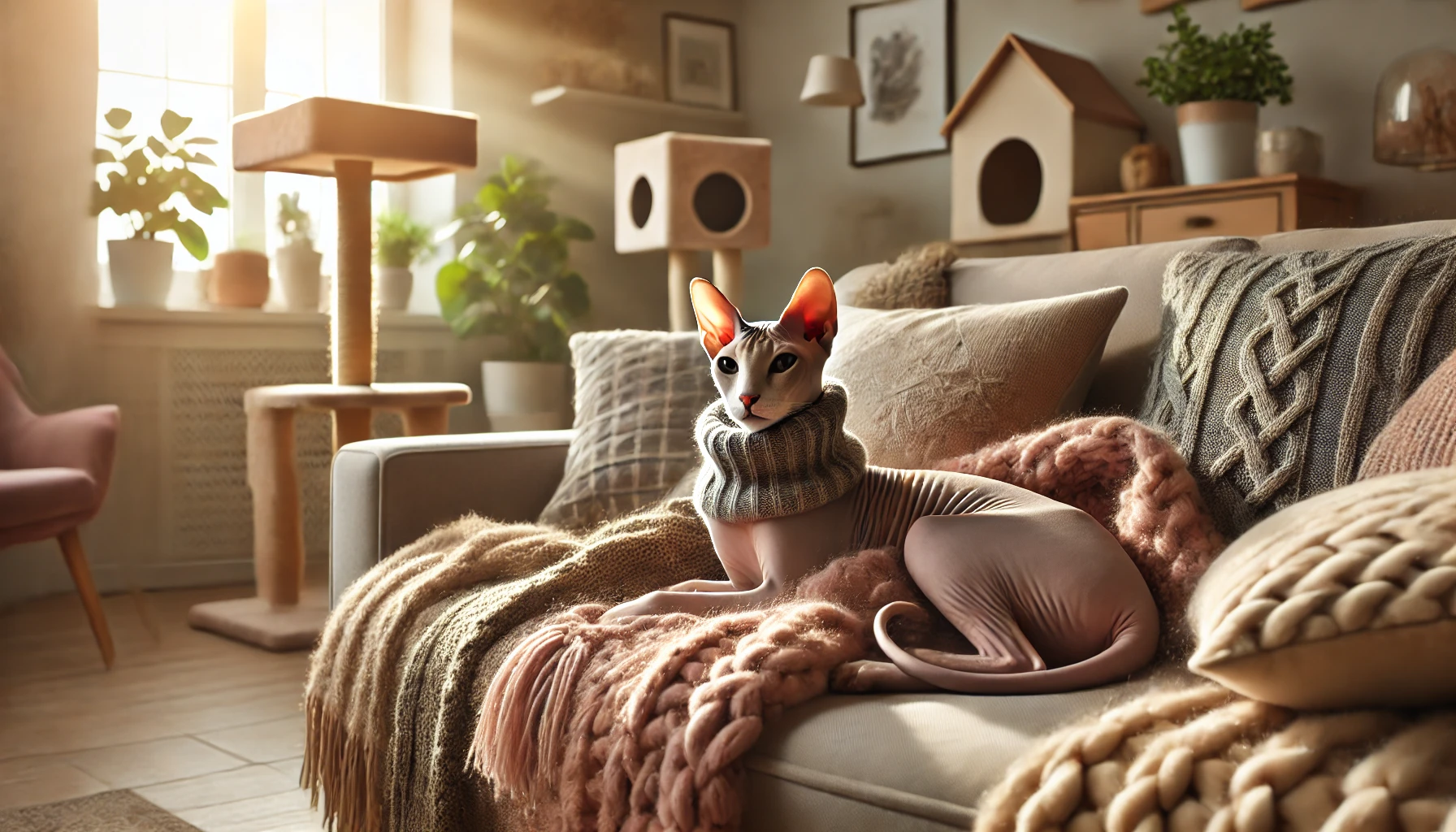
Peterbald Cats at Home: Living Environment
Peterbalds are adaptable and can thrive in a variety of living environments, but there are certain factors to consider for their comfort and health.
Their unique, hairless or lightly coated bodies, social personalities, and high energy levels mean that a Peterbald’s living environment should meet these specific needs.
Whether you live in an apartment or a larger home, here are some tips on creating the ideal living environment for your Peterbald cat.
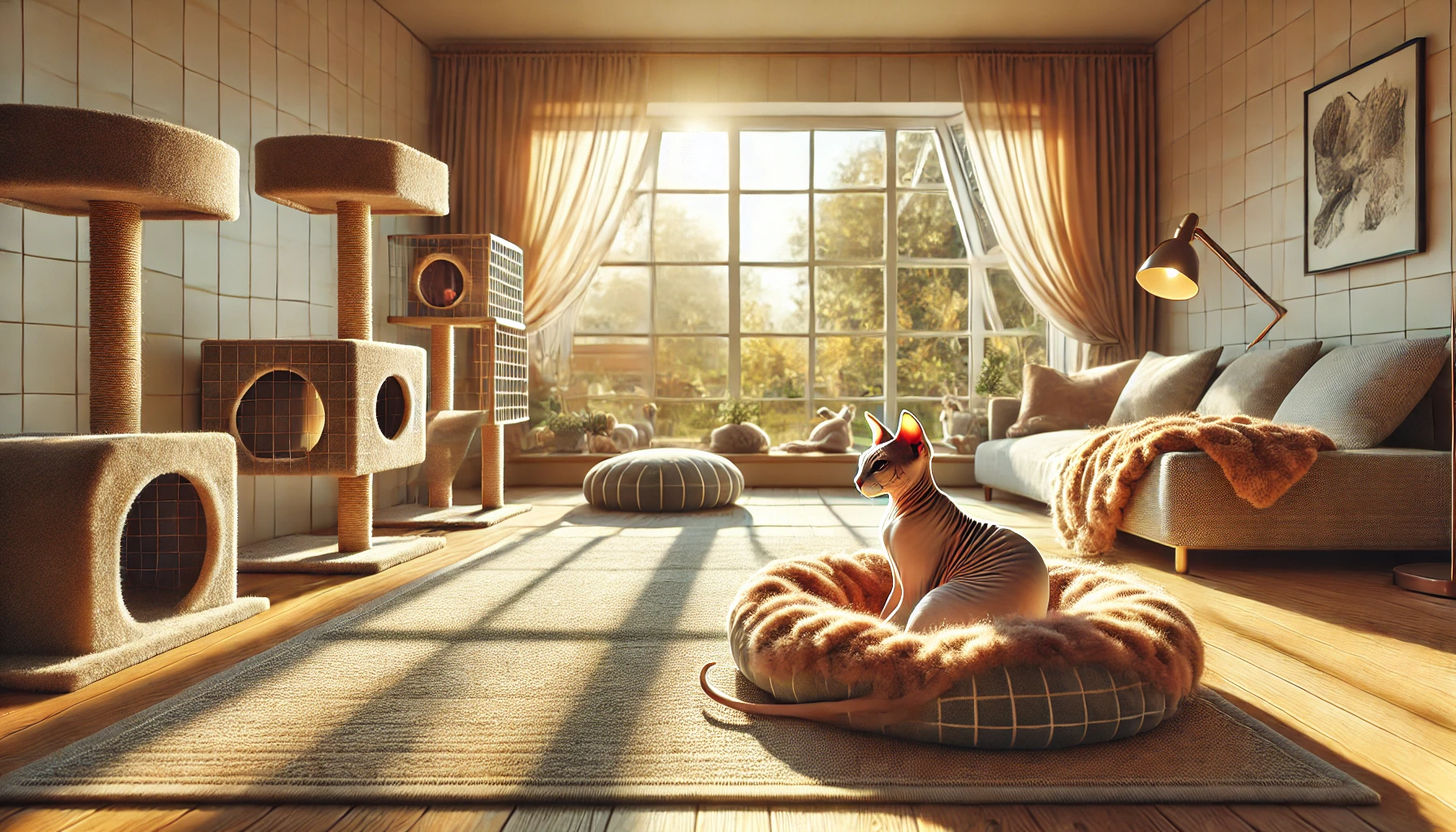
Best Indoor Settings for Peterbalds
Because they are hairless, Peterbalds are best kept indoors, as they are easily affected by outdoor conditions.
Keeping your Peterbald indoors protects them from temperature extremes, harmful UV rays, and potential infections.
Maintaining a consistent indoor temperature is key to keeping them comfortable throughout the year, especially if your home experiences seasonal temperature changes.
- Temperature Control: Peterbalds are prone to getting cold due to their hairless or lightly coated bodies. Homes with air conditioning or poor insulation may not suit them. Ensure your living space stays warm, and provide cozy spots with blankets or cat beds in warm areas of the house.
- Sun Protection: If your Peterbald enjoys lounging near windows, avoid prolonged exposure to direct sunlight to prevent sunburn on their sensitive skin. You can install curtains or shades to block sunlight when needed.
- Play Area Safety: Peterbalds are energetic and love to climb, explore, and play. Providing vertical spaces like cat trees, shelves, or designated climbing spots will keep them active and engaged. Ensure that no sharp objects or dangerous areas could cause harm during their playful exploration.
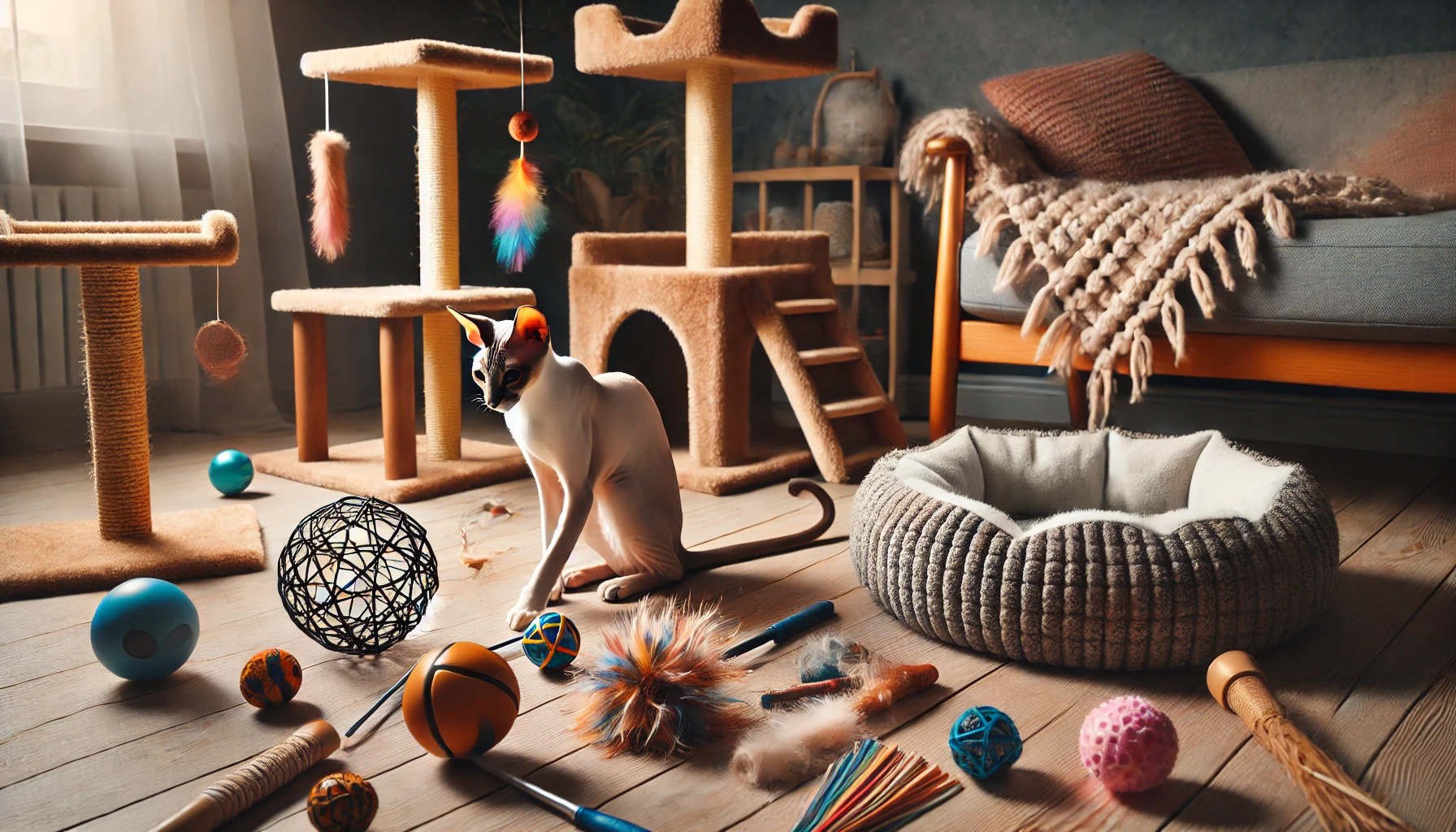
Best Toys and Accessories for Peterbald Cats
To keep your Peterbald entertained and physically active, it’s important to provide a variety of toys and accessories that challenge both their mind and body.
Being lively and intelligent cats, Peterbalds also need toys that engage their hunting instincts, promote exercise, and stimulate their minds.
- Interactive Toys: Interactive toys like feather wands, laser pointers, and puzzle feeders are perfect for Peterbalds. These toys encourage physical activity and provide mental stimulation, allowing them to expend energy while staying entertained.
- Scratching Posts: A good scratching post is essential for keeping their claws healthy and satisfying their natural scratching instinct. Vertical scratching posts or those attached to their climbing structures are great options.
- Cozy Beds: Since Peterbalds love warmth, providing soft, cozy beds in sunny or warm spots in the house gives them the perfect place to relax and nap.
By creating a warm, safe, and stimulating environment, you can keep your Peterbald happy and healthy at home.
While their unique needs require a bit more attention to detail, you’ll be rewarded with a joyful, playful, and affectionate companion in return.
Are you ready to give your Peterbald the comfortable and stimulating environment they need?
With the proper setup, these elegant cats will fit seamlessly into your home, offering endless love and companionship.
Peterbalds thrive in warm, indoor environments and need plenty of stimulation.
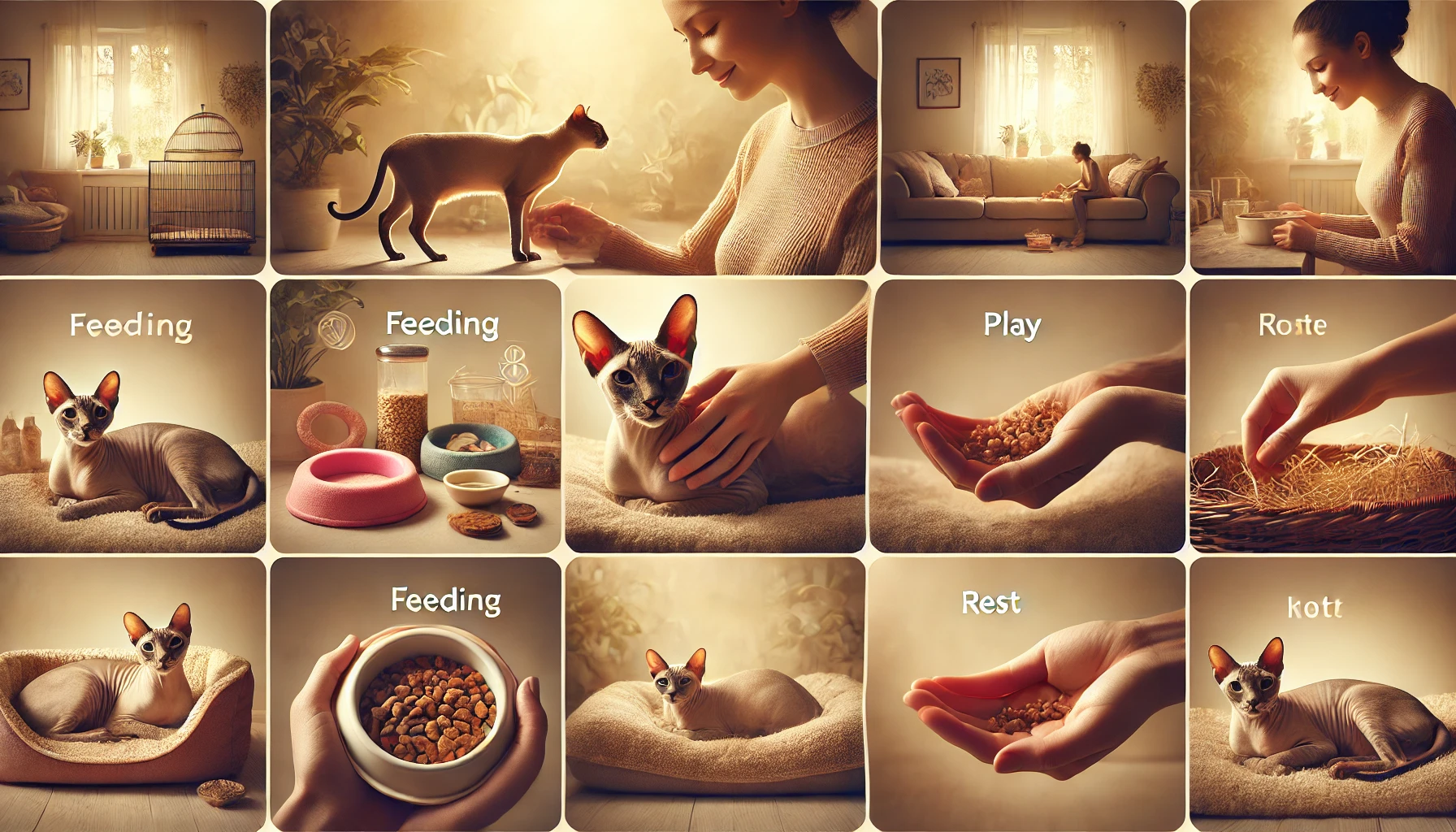
Understanding and Caring for Peterbald Cats: A Summary
The Peterbald cat represents both an interesting and elegant breed, known for its unique appearance and character.
Their specific features—hairless or lightly coated bodies, social nature, and playful energy—set them apart from other cats.
However, owning a Peterbald requires understanding their unique needs and providing a nurturing environment to ensure their well-being.
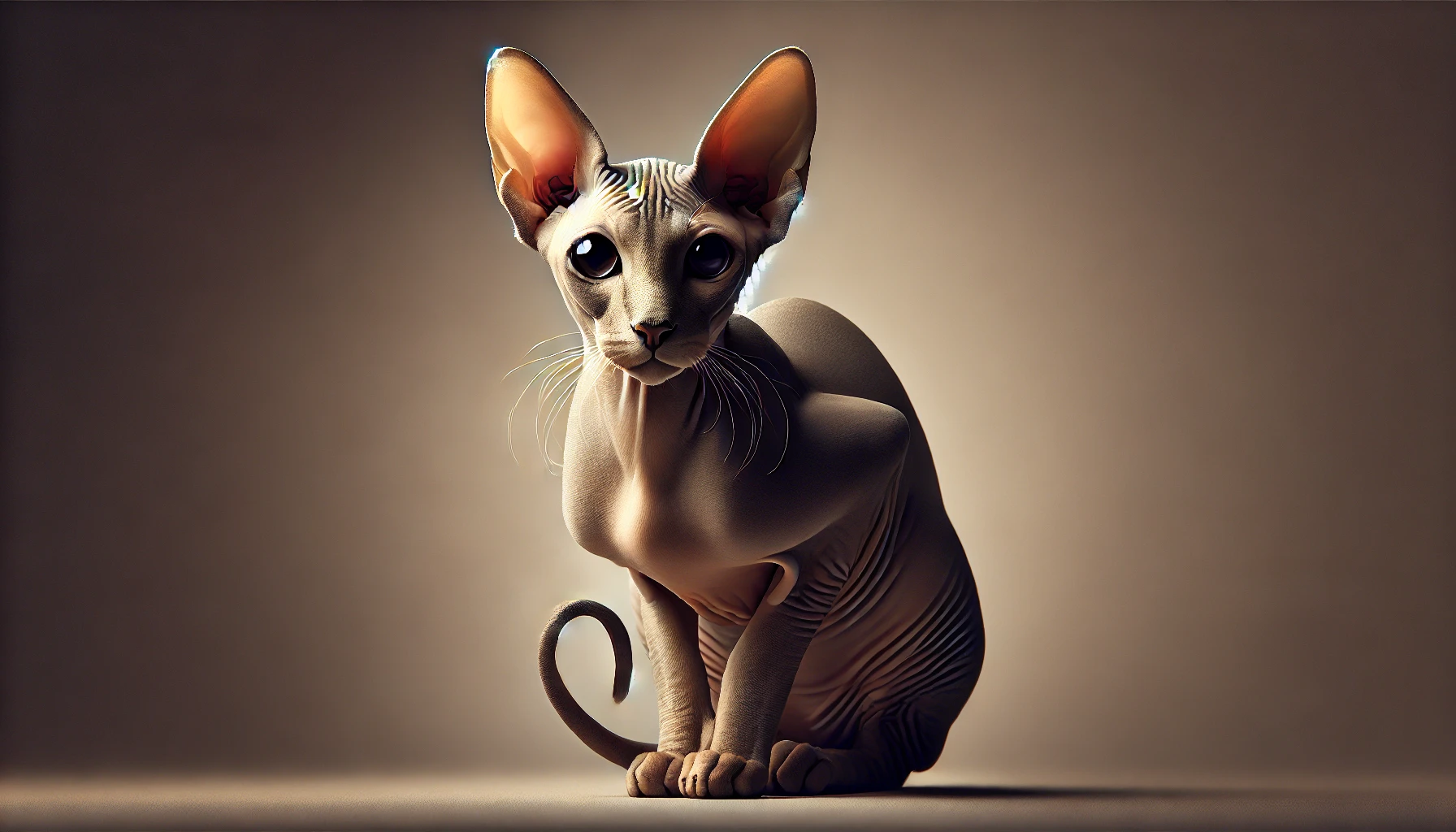
Essential Features of the Peterbald Breed
Besides being affectionate and loyal, Peterbalds are sleek and slender in build.
Here are the key traits of the Peterbald breed:
- Appearance: The breed may be hairless, velour-coated, or brush-coated, each requiring a different level of care.
- Temperament: Extremely social and people-oriented, Peterbalds attach deeply to their owners and exhibit dog-like loyalty.
- Energy Levels: Peterbalds are playful and energetic, enjoying games and mental stimulation even as they age.

Health and Care Requirements
Maintaining a Peterbald’s health involves attention to skin care, diet, and overall wellness.
Proactive care ensures they live a healthy and long life.
- Skin Care: Hairless Peterbalds need regular bathing to prevent oil buildup and skin problems. Their sun exposure should be limited, and pet-safe sunscreen can be applied to protect their sensitive skin.
- Nutrition and Weight Management: A high-protein, nutrient-rich diet suits their active nature. Portion control is essential to avoid obesity.
- Routine Veterinary Care: Regular check-ups, vaccinations, and dental care help prevent common issues like skin infections and dental diseases.
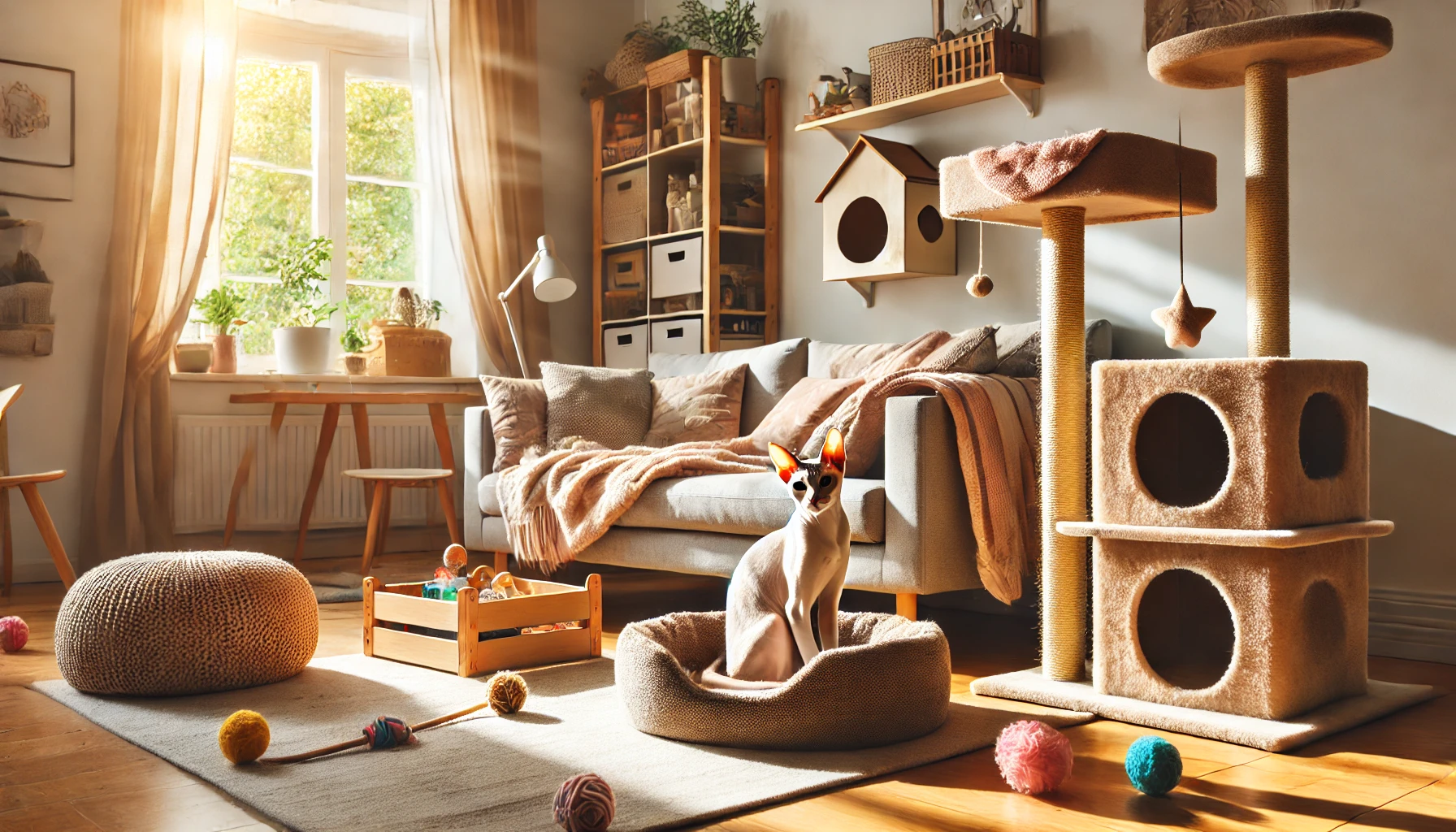
Creating an Optimal Home Environment
An ideal home environment for a Peterbald ensures their need for warmth, safety, and play is met.
- Indoor Comfort: Peterbalds should be kept indoors to avoid extreme temperatures. Providing warm spaces, such as cozy beds, helps them stay comfortable.
- Play and Stimulation: Their high energy levels require ample playtime and stimulating toys. Vertical spaces like cat trees and shelves are also beneficial for climbing and exploration.
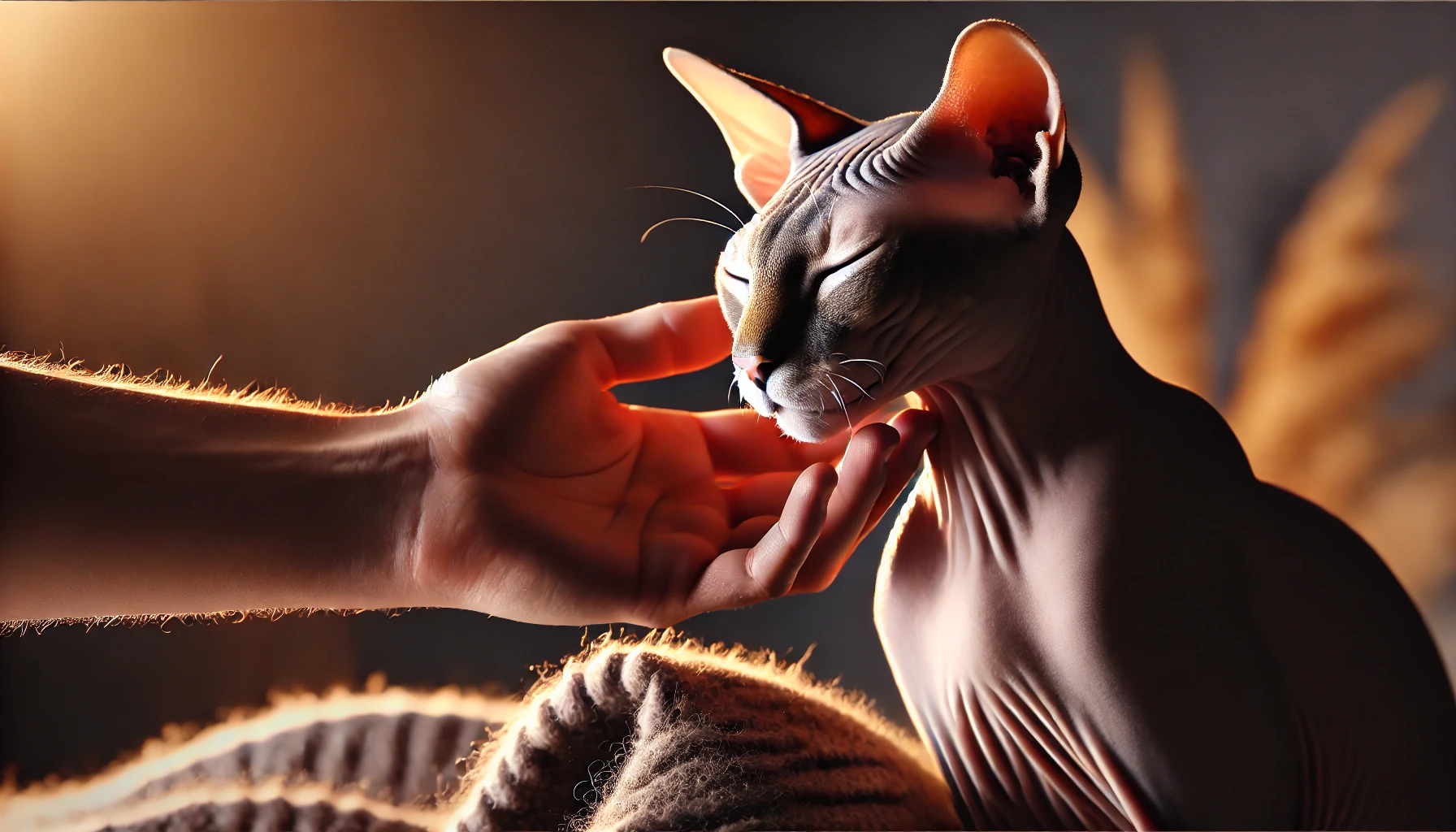
Why Pet a Peterbald?
Owning a Peterbald can be highly rewarding for cat lovers who are prepared to meet their unique needs.
In return, you’ll have a loyal, affectionate, and playful companion that thrives on human interaction and brings joy into your home.
Are you ready to welcome a Peterbald into your life?
With the proper care, environment, and attention, these beautiful cats will become a loving part of your family, offering endless affection and companionship.
Owning a Peterbald requires understanding their specific needs and providing a nurturing environment.
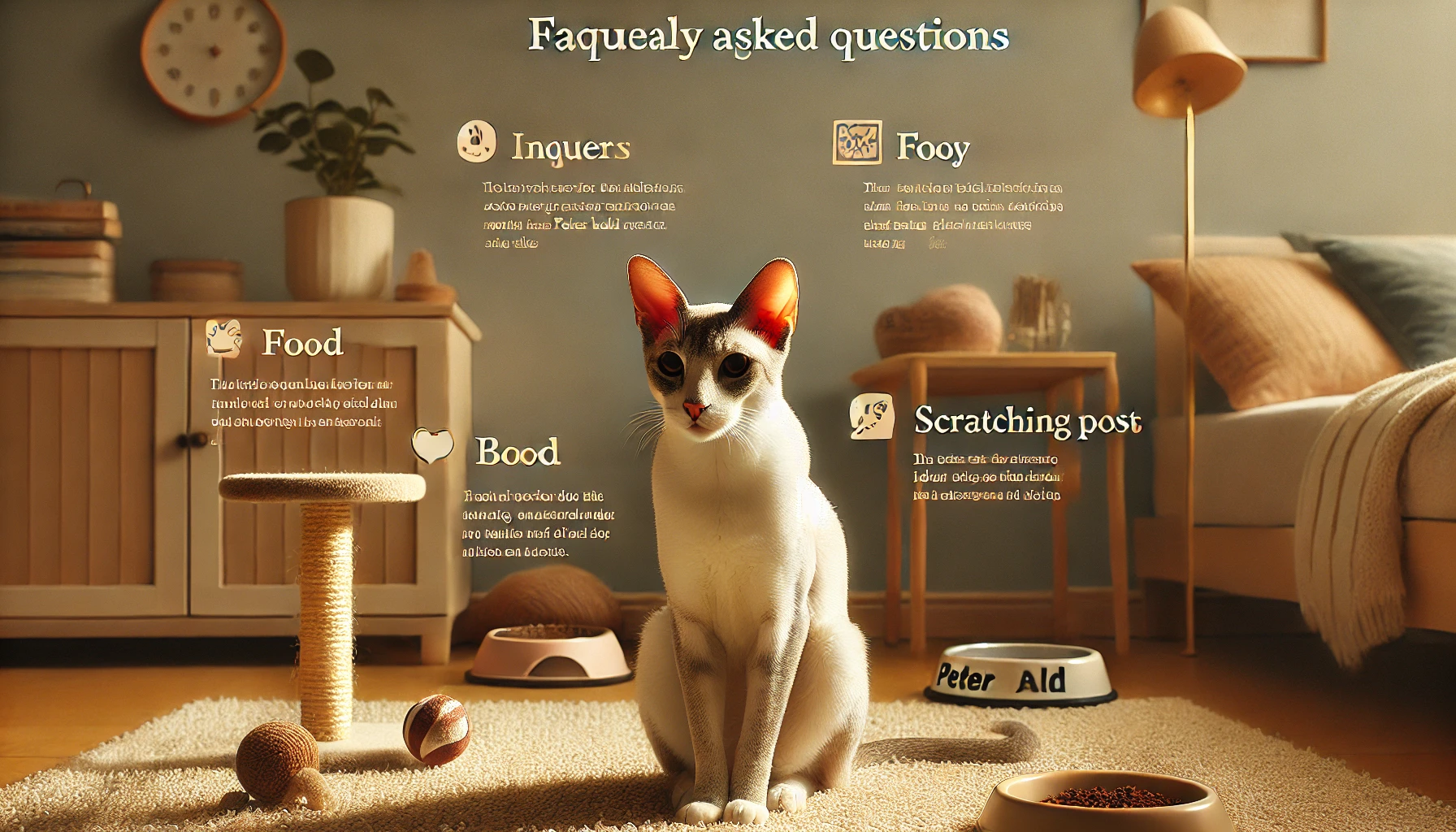
Frequently Asked Questions About Peterbald Cats
If you are looking to find out more about Peterbald cats, we have compiled a few of the most commonly asked questions concerning their care, behaviors, and traits.
These answers will help you understand what makes Peterbalds special.
Are Peterbald cats hypoallergenic?
No cat is entirely hypoallergenic, but since the Peterbald lacks fur, it is less likely to trigger allergic reactions.
Their skin still produces dander, making them less likely to be an allergenic trigger for sensitive owners.
How often should I bathe my Peterbald cat?
Hairless Peterbalds need to be bathed every 1-2 weeks to prevent oil buildup on their skin.
Regular bathing helps keep their skin clean, free of irritations or infections.
Does a Peterbald cat get along with other pets?
Yes, Peterbald cats are generally social and get along well with other pets, including dogs.
Their friendly and adaptable nature makes them suitable for multi-pet households.
Are Peterbald cats high maintenance?
Peterbalds require regular grooming, especially in terms of bathing and skin care, as well as temperature regulation.
Their energy level and need for social interaction may also require more attention than some other breeds.
What is the average life expectancy of a Peterbald cat?
On average, Peterbald cats live between 12 and 15 years.
With proper care, including regular veterinary checkups and a healthy lifestyle, they can live a long, quality life.
Should Peterbald cats be kept indoors?
Yes, because they are hairless, it is better to keep your Peterbald indoors to protect them from extreme temperatures and sunlight, which could be harmful to their sensitive skin.

